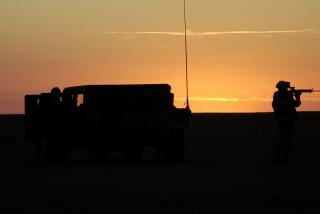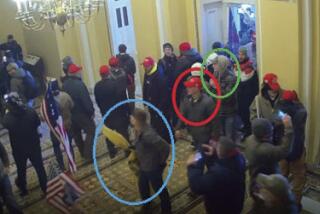Meetings in Hussein Hometown Emphasize Who’s in Control
- Share via
TIKRIT, Iraq — A day after taking control, U.S. Marines met with two groups of residents Tuesday to begin planning for a future without this city’s most famous personage: Saddam Hussein.
The first group was composed of former Baath Party loyalists and others who had prospered under Hussein’s rule. They came to the former Iraqi president’s palatial estate overlooking the Tigris River. The site, now being used by the Marines as a headquarters, was chosen for its symbolism: to emphasize that Hussein is gone and the U.S. is in charge.
The second group, tribal leaders who tolerated Hussein but never embraced him, was asked to meet near their homes, as a gesture of respect.
The first group was withdrawn and even sullen, speaking little and offering no help to the Americans. The second was enthusiastic and scheduled a second meeting to provide a list of civic needs, according to the Americans. The tribal leaders also chose a representative to handle negotiations.
Brig. Gen. John Kelly, commander of Task Force Tripoli, which swept north from Baghdad and took Tikrit after minimal fighting, said he is confident that the former party loyalists will be easier to work with as soon as Hussein’s demise sinks in.
“They were pretty withdrawn,” Kelly said while surveying the city from a promontory on the palace grounds. “But they’re also guys who need water and electricity.”
Kelly said he emphasized to both groups that the U.S. wanted to help Iraq begin taking steps toward self-governance and redress the neglect that characterized Hussein’s rule. And he asked both groups to help the U.S. identify the gunmen and snipers who were ambushing U.S. forces.
The tribal leaders said the remaining hard-core fighters were mercenaries from Syria and Jordan and promised to help find and arrest them.
The same kind of meetings have been held elsewhere in Iraq, but the sessions here have an added significance because this agricultural city of 30,000 is considered Hussein’s home. He grew up in a nearby village and began his rise to power in Tikrit.
The palace on the Tigris -- dozens of buildings on hundreds of acres -- was said to be his favorite. Images of him are so prevalent that one Marine jokingly suggested the city is a “Saddam Hussein theme park.”
Even by Baghdad standards, Tikrit is loaded with monuments, murals, pictures and icons of Hussein, seemingly on every building, flagpole and corner: the young Hussein, the older Hussein, Hussein with a gun, Hussein in tribal garb, Hussein in business suit and military uniform, Hussein in various hats.
“He was our father -- he was everywhere at once,” said one Tikriti, peering through the palace gates at the Marines pitching tents in the flower gardens.
For centuries, Tikrit was a center of commerce and intellectual life in Iraq. A Christian monastery and fortress flourished. The Islamic leader Saladin was born here and began his teachings.
But war in the 1400s demolished Tikrit and its prosperous wool and fabric trade. Only in the 20th century did the city begin to grow. There are more than 100,000 people in the area, many of whom consider Tikrit the spiritual home of their tribal alliances. It was those alliances that Hussein exploited in his rise to power.
Marine brass were worried that Hussein loyalists would retreat to Tikrit and plan a counterattack or possibly a coordinated guerrilla campaign of terror. For that reason, they cobbled together a task force of ground and air firepower to hunt down the final Republican Guard and paramilitary holdouts.
Even though resistance has been spotty and ineffectual, concern remains that Tikrit could become a rallying spot for loyalists.
Tikritis played major roles in Hussein’s government and his Baath Party. The city was favored with government projects, though, like much of Iraq, its economy was left a shambles by the sanctions imposed after the 1991 Persian Gulf War.
“Tikrit is an evil place, where evil people helped an evil man take over a country,” said a member of the Free Iraqi Forces, an opposition militia now assisting the Marines.
On Tuesday, Marines prepared to repair the electricity system, damaged by U.S. artillery and bombing, and took the first steps to provide clean water from the silty Tigris. A bridge, sabotaged by the Iraqi army as the Marines approached, was reopened. Patrols may soon begin, but looting continued Tuesday in government buildings outside the palace.
For weeks, members of the Baath Party spread stories that Tikrit had been earmarked for brutal treatment because of its connection to Hussein, according to Marine intelligence officers.
“The Tikritis are more suspicious of us,” said Lt. Col. Michael Groen, top intelligence officer for the task force. “They were convinced they were in for a rougher time than Baghdad or other cities. They have a cultural perception of how conquerors act. We have to break that down.”
One way the Marines have chosen to distinguish themselves from other conquerors is in how they are treating Hussein’s palace. While the task force has taken control of the site -- the promontory offers an excellent spot for satellite communications -- Marines are not allowed to sleep or set up work spaces inside the buildings. Even high-ranking officers are living in tents.
Young Marines were wide-eyed as they walked through the cavernous rooms with marble floors, chandeliers, gold fixtures and floor-to-ceiling windows.
“This is beyond what most of us could even consider,” said Lance Cpl. Christopher King. “To most Marines, their idea of luxury is a La-Z-Boy and a big-screen television.”
More to Read
Sign up for Essential California
The most important California stories and recommendations in your inbox every morning.
You may occasionally receive promotional content from the Los Angeles Times.













